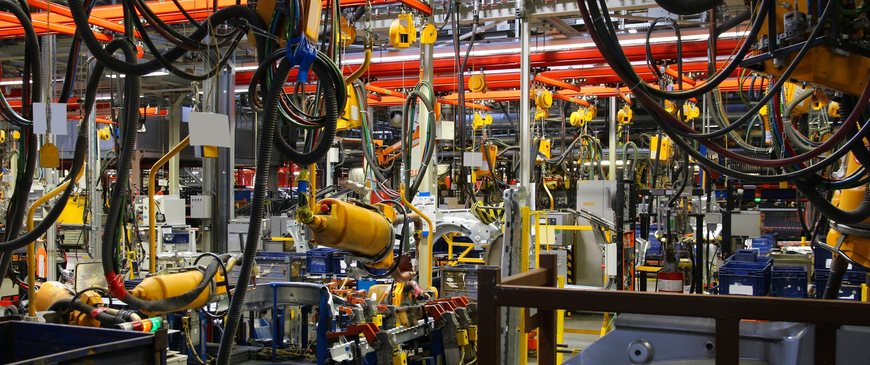
Chinese exports threaten Europe even more than the US
Biden is right to heed working class voters in Pennsylvania. The Continent, which has even more to lose from a second China shock, better start listening to its workers too.
Days after Chinese President Xi Jinping wrapped up his trip to Europe, U.S. President Joe Biden announced sweeping trade tariffs on Chinese cleantech goods, including an eye-popping 100 percent tariff on electric vehicles (EVs).
Now, the EU’s about to impose EV tariffs of its own. But Brussels doesn’t share Washington’s goal of throttling China’s development — it just wants to “derisk.” This, even though China’s exporting its way out of economic woes and causing massive trade imbalances, which threaten Europe’s economy even more than they threaten America’s.
It’s time Europe woke up.
Since the late 1980s, China’s growth model has relied on chronically low domestic consumption and recycling the resulting savings glut into increasingly low-return investment. Overproduction has become a permanent feature, with China’s manufacturing exports surging from 2.3 percent of the world’s total in 1991 to 19 percent in 2013, all aided by protectionism, subsidies and theft of Western intellectual property.
During this period, the U.S. lost roughly 1 million manufacturing jobs to Chinese import competition — jobs that were regionally concentrated, for example, in the country’s Midwest, and most of these workers were condemned to long-term unemployment. The EU — especially Germany — was more sheltered from this, as its manufacturers could cut costs by shifting supply chains to new, cheaper Central and Eastern European member countries.
However, a second China shock is now rapidly unfolding. And unlike the first one, this one affects sectors at the heart of Europe’s economy.
After China’s property bubble burst in late 2023, Xi directed the country’s savings toward making cars, chemicals, machinery and chips. And China has been dumping the resulting overproduction on global markets to avoid unemployment at home. Today, the country provides 13 percent of global consumption while delivering 31 percent of manufacturing output.
As such, the EU’s now poised to potentially lose many more jobs than the U.S. did during the first shock. The bloc currently has around 30 million manufacturing jobs compared to the 17 million the U.S. had in 2000. And this shock — measured as China’s manufactures trade surplus as a share of global GDP — is also almost twice as large as the last one.
According to the Economist and many experts in the field, however, the EU should simply buy these cheap climate-transition goods and send a thank you note to Beijing for depressing their prices with subsidies. Their bet is that Europe can redirect its capital and labor to other sectors — but this strategy is highly risky.
In contrast to the U.S., Europe’s culture and social safety nets promote strong links between employers and employees, ossifying its sectoral makeup. The European economy is also less dynamic, and its workers are less mobile than those in the U.S.
Moreover, this second China shock will shrink Europe’s most productive sectors. In the 2010s, EU manufacturing productivity grew by 1.7 percent annually, compared to only 0.3 to 0.8 percent growth in services. The tech sector outpaced both with 2.4 percent yearly growth in output per worker, but tech offers little hope for the EU, where it comprises only 5.5 percent of GDP compared to 9.3 percent in the U.S.
As a result of all this, innovation in Europe may well decline too. Monopolies tend to undermine innovation, but so does excessive competition and downward price pressure. EU cleantech firms now face massive Chinese overproduction, as well as restricted access to the Chinese market, while their Chinese competitors can access both markets. This will inevitably choke off the profits needed to reinvest in the next generation of products and machines — much like how accelerating import competition from China is estimated to have accounted for 40 percent of the slowdown in U.S. patenting in affected industries between 1999 and 2007.
And while firms’ investments generally come to benefit the whole economy — as workers transmit knowledge of production processes and product innovations when changing employers — Europe will miss out on these learning spillovers, especially in promising infant cleantech industries that won’t reach sufficient scale due to Chinese overproduction. Furthermore, by knocking Europe out of the race, China could lower the global rate of innovation in cleantech as well.
So far, Europe’s main rationale in responding to Chinese mercantilism has been avoiding key dependencies on a strategic rival. But “derisking” some supply chains in response to China’s massive trade imbalances is like bringing a knife to a gunfight. What’s really required is muscular macroeconomic policy.
Brussels should act on its subsidies investigations with sizeable but more targeted tariffs than the U.S., prioritizing protection for viable employment-rich sectors, like EVs and wind turbines. EU countries should also encourage local production by making green subsidies conditional on firms avoiding carbon emissions from transporting goods over long distances. Conversely, the bloc can permit the glut of Chinese imports in areas where it lacks industry — such as solar panels.
China will, of course, strike back. But it can’t miss out on access to both the U.S. and EU markets — which may limit retaliation and give the EU leverage.
For Europe, failing to act forcefully could mean significant deindustrialization, even slower growth and a massive political backlash to the climate transition. Biden is right to listen to working class voters in Pennsylvania. The Continent, which has even more to lose from this China shock, better start listening too.
Sander Tordoir is chief economist at the Centre for European Reform.
